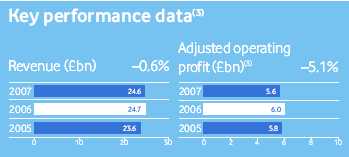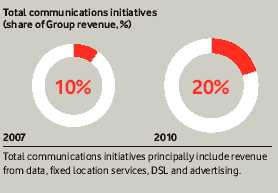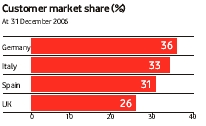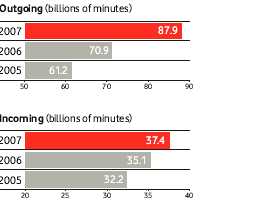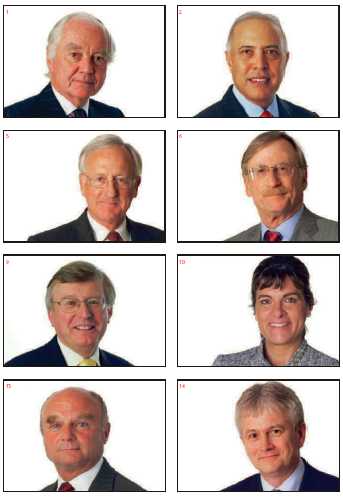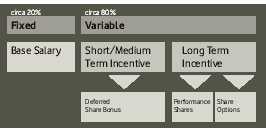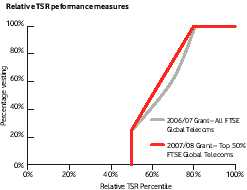We have audited the accompanying consolidated balance sheets of Cellco Partnership d/b/a Verizon Wireless (the “Partnership”) as of December 31, 2006 and 2005, and the related consolidated statements of operations and comprehensive income, changes in partners’ capital, and cash flows for each of the three years in the period ended December 31, 2006. These financial statements are the responsibility of the Partnership's management. Our responsibility is to express an opinion on the financial statements based on our audits.
We conducted our audits in accordance with the standards of the Public Company Accounting Oversight Board (United States). Those standards require that we plan and perform the audit to obtain reasonable assurance about whether the financial statements are free of material misstatement. An audit includes examining, on a test basis, evidence supporting the amounts and disclosures in the financial statements. An audit also includes assessing the accounting principles used and significant estimates made by management, as well as evaluating the overall financial statement presentation. We believe that our audits provide a reasonable basis for our opinion.
In our opinion, such consolidated financial statements present fairly, in all material respects, the financial position of the Partnership as of December 31, 2006 and 2005, and the results of its operations and its cash flows for each of the three years in the period ended December 31, 2006, in conformity with accounting principles generally accepted in the United States of America.
Back to Contents
Return of Capital and Share Consolidation
Background
The Company implemented a transaction to return capital to shareholders (the “Return of Capital”) during the year by way of an issue (the “Bonus Issue”) of redeemable, non-cumulative preference shares (the “B Shares”) to shareholders in proportion to their holding of ordinary shares or ADRs immediately prior to the Bonus Issue (the “Pre-existing Shares” and the “Pre-existing ADRs” respectively). Under the Return of Capital, holders of the Pre-existing Shares could elect to have one of the following alternatives apply (with certain classes of persons located in the US along with holders of Pre-existing ADRs only permitted to participate in the second alternative below):
(i) the shareholder could elect to redeem the B Shares at their nominal value on 4 August 2006 (the “Initial Redemption”);
(ii) the shareholder could elect to receive a single dividend of an amount equal to the nominal value of the B Shares on a specified date in August 2006 (the “Initial B Share Dividend”) following which the shares automatically converted into unlisted deferred shares (the “Deferred Shares”); or
(iii) the shareholder could elect to redeem the B Shares at their nominal value at a later date being 5 February or 5 August in the calendar year 2007 or 2008 (the “Future Redemption”) with the shareholder receiving a continuing, non-cumulative preferential dividend on the B Shares in the meantime.
At the same time, the Pre-existing Shares and the Pre-existing ADRs were sub-divided and consolidated (the "Share Capital Consolidation"). The Share Capital Consolidation and the Bonus Issue are together referred to as the "Capital Reorganisation". The shares and ADRs following sub-division and consolidation are referred to below as "New Shares" or "New ADRs" in order to distinguish them from the Pre-existing Shares and Pre-existing ADRs.
UK Taxation
The comments below are intended only as a general guide to the current tax position under the laws of the United Kingdom and practice of Her Majesty’s Revenue and Customs primarily in respect of US holders who are (except where specifically addressed) solely resident in the United Kingdom for tax purposes and who hold their shares beneficially as investments and not on trading account. This is a complex area and shareholders should consult their tax advisers in order to be certain of their individual position.
1. Capital Reorganisation
For the purposes of United Kingdom taxation of capital gains and corporation tax on chargeable gains (“CGT”):
1.1 the receipt of the B Shares and the New Shares arising from the Capital Reorganisation was a reorganisation of the share capital of the Company. Accordingly, a shareholder will not be treated as having made a disposal of all or part of their holding of Pre-existing Shares by reason of the Capital Reorganisation;
1.2 the B Shares and New Shares acquired as a result of the Capital Reorganisation are to be treated as the same asset as the shareholder’s holding of Pre-existing Shares, and as having been acquired at the same time as the shareholder’s holding of Pre-existing Shares were acquired; and
1.3 any proceeds of sale of fractional entitlements returned to shareholders are not to be treated as proceeds of disposal but the amount will be deducted from the base cost on acquisition of the Pre-existing Shares.
2. Initial B Share Dividend
2.1 Income Tax
The Company did not (and was not required to) withhold tax at source when paying the Initial B Share Dividend.
A United Kingdom resident individual shareholder liable to income tax at the starting or basic rate pays no tax on the Initial B Share Dividend unless it has taken that shareholder’s income into a higher rate tax band.
A United Kingdom resident individual shareholder liable to income tax at the higher rate is liable to pay tax equal to 25% of the cash dividend received to the extent that the gross dividend when treated as the top slice of that shareholder’s income falls above the threshold for higher rate income tax.
United Kingdom resident taxpayers not liable to United Kingdom tax on dividends are not generally liable to pay tax on the Initial B Share Dividend.
United Kingdom resident corporate shareholders are generally not subject to corporation tax on the Initial B Share Dividend.
2.2 Taxation of chargeable gains
For CGT purposes, the Initial B Share Dividend (and the consequent conversion of the B Shares into Deferred Shares) should not be treated as having given rise to a disposal or part disposal of the B Shares.
Shareholders who have received the Initial B Share Dividend should note that, consequent to the Capital Reorganisation, a proportion of the base cost, for CGT purposes, of their original holdings of Pre-existing Shares is to be attributed to the B Shares and this amount is to continue to be attributed to those B Shares following their conversion into Deferred Shares (notwithstanding that the Deferred Shares have limited rights or value). Correspondingly, only a proportion of the base cost of the holding of Pre-existing Shares is available on any disposal of New Shares.
A transfer of the Deferred Shares is to be treated as a disposal and might result in a shareholder realising a capital loss. However, shareholders liable to corporation tax should note that it is possible that Section 30 of the Taxation of Chargeable Gains Act 1992 could apply to such a shareholder who elected for the Initial B Share Dividend. If it were so applied, the effect is broadly to deny any loss attributable to the payment of that Initial B Share Dividend from being allowed on disposal of the Deferred Shares.
3. Redemption of B Shares
3.1 On redemption (whether an Initial Redemption or a Future Redemption) of all or any of the B Shares, a shareholder might, depending on their particular circumstances, be subject to CGT on the amount of any chargeable gain realised. Any gain is measured by reference to the excess of the redemption price over the shareholder’s allowable expenditure for the B Shares redeemed. The shareholder’s allowable expenditure in relation to his Pre-existing Shares is to be apportioned between the New Shares and the B Shares by reference to their respective market values on the first day on which market values or prices were quoted or published for the New Shares.
3.2 No part of the proceeds received by a shareholder on redemption is an income distribution in the shareholder’s hands.
3.3 On any disposal, otherwise than by way of redemption, of the whole or part of a shareholder’s holding of New Shares or B Shares, a shareholder may, depending on his circumstances, be subject to CGT on the amount of any chargeable gain realised. Please refer to paragraph 3.1 above for details of the manner in which the shareholder’s allowable expenditure is allocated as between the New Shares and the B Shares.
B-1
4. Dividends on New Shares and B Shares other than the Initial B Share Dividend
Dividends payable on the New Shares and the B Shares are subject to United Kingdom tax under the rules applicable to dividends. Under current United Kingdom taxation legislation, no tax is withheld at source from dividends paid on the New Shares or on the B Shares. The current rules and rates of tax correspond to those outlined in paragraph 2.1 above.
5. Stamp Duty and Stamp Duty Reserve Tax
5.1 Except in relation to depositary receipt arrangements or clearance services where special rules apply:
• no stamp duty or stamp duty reserve tax (“SDRT”) is payable on the issue of the B Shares and New Shares; and
• an agreement to sell B Shares or New Shares normally gives rise to liability on the purchaser to SDRT, at the rate of 0.5% of the actual consideration paid. If an instrument of transfer of the B Shares is subsequently produced it would generally be subject to stamp duty at the rate of 50 pence for every £100 (or part thereof) of the actual consideration paid. When such stamp duty is paid, the SDRT charge is cancelled and any SDRT already paid is refunded. Stamp duty and SDRT is generally the liability of the purchaser.
5.2 Where shareholders elect to redeem B Shares, the redemption of those B Shares by the Company does not give rise to a liability to stamp duty or SDRT.
5.3 In relation to the special rules applicable to depositary receipt arrangements, no stamp duty or SDRT should be payable in respect of the issue of the B Shares or Deferred Shares to the Depositary for the Holders of Pre-existing ADRs. Nor will any such charge arise in connection with the issue of New ADRs.
6. Section 703 Income and Corporation Taxes Act 1988 (“ICTA”) and Section 684 Income Tax Act 2007 (“ITA”)
The Company has been advised that the provisions of section 703 of ICTA (and, as rewritten for income tax purposes, section 684 of ITA) (anti-avoidance provisions relating to transactions in shares) should not apply in relation to shareholders who received B Shares in the Capital Reorganisation. The Company did not apply for clearance under section 707 of ICTA (or section 701 of ITA) in this regard.
US Taxation
The discussion below summarises certain US federal income tax consequences for US holders subject to alternative ii: the Initial B Share Dividend and does not describe potential consequences to investors that receive one of the other alternatives described above. This section only addresses US Holders that hold their Pre-existing Shares as capital assets and does not address tax consequences applicable to Shareholders subject to special treatment under the US federal income tax laws (for example, dealers or traders in securities or currencies, banks, insurance companies, tax-exempt organisations, partnerships or other pass-through entities, persons who own 10% or more of the voting stock of the Company, persons holding Pre-existing Shares as part of a straddle, hedging, integrated or similar transaction, and persons whose functional currency is not the US dollar). This summary is based upon the provisions of the Internal Revenue Code of 1986, as amended (the “Code”), and regulations, rulings and judicial decisions as of the date hereof. Those authorities may be changed, perhaps retroactively, so as to result in US federal income tax consequences different from those discussed below.
If a partnership holds Pre-existing Shares, the tax treatment of a partner will generally depend upon the status of the partner and the activities of the partnership. If you are a partner of a partnership which held Pre-existing Shares, you should consult your tax advisers.
This summary assumes that the Deferred Shares have no value, and therefore receipt of the Deferred Shares have no consequences for US federal income tax purposes.
Each Shareholder should consult its own tax advisers concerning the US federal income tax consequences in light of its particular situation as well as any consequences arising under the laws of any other taxing jurisdiction.
The Initial B Share Dividend
To the extent paid out of the current or accumulated earnings and profits of the Company (as determined under US tax principles), beneficial owners of Pre-existing Shares should be treated as receiving a dividend for US federal income tax purposes upon the receipt of the Initial B Share Dividend and should not be separately taxed upon the receipt of the B Shares, the conversion of Pre-existing Shares into New Shares (except to the extent of any cash received in respect of fractional shares) or the conversion of B Shares into Deferred Shares. Such beneficial owners should generally have the same holding period and basis in the New Shares received as they had in their Pre-existing Shares (except such basis may be reduced to the extent attributable to any fractional shares for which cash is received).
However, there is no direct authority addressing the treatment of securities similar to the B Shares or the associated conversion of Pre-existing Shares into New Shares and US Holders should consult their own tax advisers with respect to the appropriate US federal income tax treatment of receiving the Initial B Share Dividend.
The dividend is treated as ordinary income from foreign sources. With respect to US Shareholders that do not hold Pre-existing ADRs, the amount of the dividend treated as received generally equals the US dollar value of the sterling received by you calculated by reference to the exchange rate in effect on the date of the Initial B Share Dividend regardless of whether the sterling is converted into US dollars. If the sterling received is not converted into US Dollars on the date of receipt, such US Shareholders has a tax basis in the sterling equal to such US dollar value and any gain or loss realised on a subsequent conversion or other disposal of the sterling will be treated as US source ordinary income or loss. Amounts payable to holders of Pre-existing ADRs in respect of the Initial B Share Dividend are paid in US dollars by the Depositary (less US withholding taxes, if any). For individuals, such dividends are generally taxed at a reduced maximum tax rate of 15%, subject to certain limitations, including a holding period requirement. Such reduced rate is not available to Shareholders that elect to treat dividend income as “investment income” pursuant to section 163(d)(4) of the Code or that are obligated to make related payments with respect to positions in substantially similar or related property. Individuals should consult their own tax advisers regarding their eligibility to claim such reduced rate based on their particular circumstances.
Such dividend is not eligible for the dividends received deduction generally allowed to corporations under the Code.
To the extent that the amount of the Initial B Share Dividend exceeds a US Holder’s allocable share of the Company’s current and accumulated earnings and profits, the distribution is first treated as a tax-free return of capital, causing a reduction in the adjusted basis of the Pre-existing Shares (thereby increasing the amount of gain, or decreasing the amount of loss, recognised on a subsequent disposition of the New Shares), and the balance in excess of adjusted basis is taxed as US source capital gain recognised on a sale or exchange. However, the Company expects that the distribution will not exceed its current and accumulated earnings and profits.
B-2
SIGNATURE
The registrant hereby certifies that it meets all of the requirements for filing on Form 20-F and that it has duly caused and authorized the undersigned to sign this transition report on its behalf.
| | VODAFONE GROUP PUBLIC LIMITED COMPANY
(Registrant) |
| | |
| | |
| | /s/ Arun Sarin |
| | Arun Sarin |
| | Chief Executive |
Dated: 14 June 2007
Index to Exhibits to Form 20-F for year ended 31 March 2007
| 1.1 | | Memorandum, as adopted on June 13, 1984 and including all amendments made on July 28, 2000 and July 26, 2005 (incorporated by reference to Exhibit 1 to the Company’s Annual Report of Form 20-F for the financial year ended March 31, 2006). |
| | | |
| 1.2 | | Articles of Association, as adopted on June 30, 1999 and including all amendments made on July 25, 2001, July 26, 2005, and July 25, 2006 of the Company. |
| | | |
| 2. | | Indenture, dated as of February 10, 2000, between the Company and Citibank, N.A. as Trustee, including forms of debt securities (incorporated by reference to Exhibit 4(a) of Amendment No. 1 to the Company’s Registration Statement on Form F-3, dated November 24, 2000). (File No. 333-10762)). |
| | | |
| 4.1 | | Agreement for US $5,525,000,000 5 year Revolving Credit Facility (subsequently increased by accession of further lenders to US$5,925,000,000), dated 24 June 2004, among, inter alia, the Company, ABN Amro Bank N.V.; Banco Bilbao Vizcaya Argentaria S.A. ; Bank of America, N.A.; Barclays Bank PLC; Bayerische Hypo-und Vereinsbank AG; BNP Paribas ; CALYON; Citibank, N.A.; Commerzbank Aktiengesellschaft, London Branch; Deutsche Bank AG; HSBC Bank plc; ING Bank, N.V.; JPMorgan Chase Bank; Lehman Brothers Bankhaus AG; Lloyds TSB Bank plc; Morgan Stanley Dean Witter Bank Limited and Morgan Stanley Bank; Mizuho Corporate Bank, Ltd.; National Australia Bank Limited ABN 12 004 044 937; Sumitomo Mitsui Banking Corporation Europe Limited; The Bank of Tokyo-Mitsubishi, Ltd.; The Royal Bank of Scotland Plc; UBS AG; WestLB AG; Banco Santander Central Hispano, S.A.; William Street Commitment Corporation; Banca Intesa SpA; KBC Bank NV; Standard Chartered Bank; TD Bank Europe Limited; and The Bank of New York with The Royal Bank of Scotland plc as Agent and US Swingline Agent, as amended and restated on 24 June 2005 by Supplemental Agreement among, inter alia, the Company, ABN AMRO Bank N.V.; Banc of America Securities Limited; Banco Bilbao Vizcaya Argentaria S.A.; Banco Santander Central Hispano, S.A. London Branch; Barclays Capital; Bayerische Hypo-und Vereinsbank AG; BNP Paribas; Calyon; Citigroup Global Markets Limited; Commerzbank Aktiengesellschaft, London Branch; Deutsche Bank AG London; HSBC Bank Plc; ING Bank N.V., London Branch; JPMorgan Chase Bank, N.A.; J.P. Morgan Plc; Lehman Commercial Paper Inc.; Llloyds TSB Bank Plc; Mizuho Corporate Bank, Ltd; Morgan Stanley Bank International Limited; National Australia Bank Limited ABN 12 004 044 937; Sumitomo Mitsui Banking Corporation Europe Limited; The Bank of Tokyo-Mitsubishi, Ltd.; The Royal Bank of Scotland Plc; UBS Limited; WestLB AG, London Branch; William Street Commitment Corporation; Banca Intesa SpA; KBC Bank NV; Standard Chartered Bank; TD Bank Europe Limited; The Bank of New York; ABN AMRO Bank N.V.; Banca Intesa SpA; Banco Bilbao Vizvcaya Argentaria S.A.; Banco Bilbao Vizvcaya Argentaria S.A. (New York Branch); Banco Santander Central Hispano, S.A. London Branch; Bank of America, N.A.; Barclays Bank Plc; Bayerische Hypo-und Vereinsbank AG; BNP Paribas (London Branch); BNP Paribas (acting through its New York Branch); Calyon; Citibank, N.A.; Commerzbank Aktiengesellschaft, London Branch; Commerzbank Aktiengesellschaft, New York Branch; Deutsche Bank AG London; Deutsche Bank AG New York; HSBC Bank Plc; ING Bank N.V., London Branch; JPMorgan Chase Bank, N.A.; KBC Bank NV; Lehman Commercial Paper Inc.; Lloyds TSB Bank Plc; Mizuho Corporate Bank, Ltd.; Morgan Stanley Bank; Morgan Stanley Bank International Limited; National Australia Bank Limited ABN 12 004 044 937; Standard Chartered Bank; Sumitomo Mitsui Banking Corporation Europe Limited; TD Bank Europe Limited; The Bank of New York; The Bank of Tokyo-Mitsubishi, Ltd.; The Royal Bank of Scotland Plc; The Royal Bank of Scotland Plc (New York Branch); UBS AG, London Branch; UBS AG, Stamford Branch; UBS Loan Finance LLC; WestLB AG, London Branch; WestLB AG, New York Branch; William Street Commitment Corporation; and The Royal Bank of Scotland Plc with The Royal Bank of Scotland Plc (New York Branch) as Agent and U.S. Swingline Agent (incorporated by reference to Exhibit 4.1 to the Company’s Annual Report on Form 20-F for the financial year ended March 31, 2006) |
| 4.2 | | Lender Accession Agreement with Merrill Lynch International Bank Limited, effective as of May 8, 2007. |
| | | |
| 4.3 | | Agreement for US$4,675,000,000 7 year Revolving Credit Facility (subsequently increased by accession of further lenders to US$5,025,000,000), dated June 24, 2005, among, inter alia, the Company, Banc of America Securities Limited; Banca Intesa SpA; Banco Bilboa Vizcaya Argentaria S.A.; Banco Santander Central Hispano, S.A. London Branch; Barclays Capital; Bayerische Hypo-und Vereinsbank AG; BNP Paribas; Calyon; Citigroup Global Markets Limited; Deutsche Bank AG London; HSBC Bank Plc; ING Bank N.V., London Branch; J.P. Morgan Plc; Lehman Commercial Paper Inc., UK Branch; Lloyds TSB Bank Plc; Mizuho Corporate Bank, Ltd; Morgan Stanley Bank International Limited; National Australia Bank Limited ABN 12 004 044 937; The Bank of Tokyo-Mitsubishi, Ltd; The Royal Bank of Scotland Plc; UBS Limited; Unicredit Banca d’Impresa SpA; WestLB AG, London Branch; William Street Commitment Corporation; Commerzbank Aktiengesellschaft, Filiale Düsseldorf; KBC Bank NV; Standard Chartered Bank; TD Bank Europe Limited; The Bank of New York; Banca Intesa SpA; Banco Bilbao Vizcaya Argentaria S.A.; Banco Bilbao Vizcaya Argentaria S.A. (New York Branch); Banco Santander Central Hispano, S.A. London Branch; Bank of America, N.A., Barclays Bank Plc; Bayerische Hypo-und Vereinsbank AG; BNP Paribas (London Branch); BNP Paribas, New York Branch; Calyon; Citibank, N.A.; Commerzbank Aktiengesellschaft, Filiale Düsseldorf; Deustche Bank AG London; Deutsche Bank AG New York; HSBC Bank Plc; ING Bank N.V., London Branch; JPMorgan Chase Bank, N.A.; KBC Bank NV; Lehman Commercial Paper Inc., UK Branch; Lloyds TSB Bank Plc; Mizuho Corporate Bank, Ltd.; Morgan Stanley Senior Funding, Inc.; Morgan Stanley Bank International Limited; National Australia Bank Limited ABN 12 004 044 937; Standard Chartered Bank; TD Bank Europe Limited; The Bank of New York; The Bank of Tokyo-Mitsubishi, Ltd.; The Royal Bank of Scotland Plc; The Royal Bank of Scotland Plc (New York Branch); UBS AG, London Branch; UBS Loan Finance LLC; Unicredit Banca d’Impresa SpA; WestLB AG, London Branch; WestLB AG, New York Branch; William Street Commitment Corporation; and The Royal Bank of Scotland plc with The Royal Bank of Scotland Plc (New York Branch) as Agent and US Swingline Agent. (incorporated by reference to Exhibit 4.2 to the Company’s Annual Report on Form 20-F for the financial year ended March 31, 2006) |
| | | |
| 4.4 | | Lender Accession Agreement with Merrill Lynch International Bank Limited, effective as of May 8, 2007. |
| | | |
| 4.5 | | Vodafone Group Long Term Incentive Plan (incorporated by reference to Exhibit 4.5 to the Company’s Annual Report on Form 20-F for the financial year ended March 31, 2001). |
| | | |
| 4.6 | | Vodafone Group Short Term Incentive Plan (incorporated by reference to Exhibit 4.6 to the Company’s Annual Report on Form 20-F for the financial year ended March 31, 2001). |
| | | |
| 4.7 | | Vodafone Group 1999 Long Term Stock Incentive Plan (incorporated by reference to Exhibit 4.7 to the Company’s Annual Report on Form 20-F for the financial year ended March 31, 2001). |
| | | |
| 4.8 | | Vodafone Group 1998 Company Share Option Scheme (incorporated by reference to Exhibit 4.8 to the Company’s Annual Report on Form 20-F for the financial year ended March 31, 2001). |
| 4.9 | | Vodafone Group 1998 Executive Share Option Scheme (incorporated by reference to Exhibit 4.9 to the Company’s Annual Report on Form 20-F for the financial year ended March 31, 2001). |
| | | |
| 4.10 | | Vodafone Group 2005 Global Incentive Plan (incorporated by reference to Exhibit 4.8 to the Company’s Annual Report on Form 20-F for the financial year ended March 31, 2006). |
| | | |
| 4.11 | | Service Contract of Arun Sarin (incorporated by reference to Exhibit 4.20 to the Company’s Annual Report on Form 20-F for the financial year ended March 31, 2003). |
| | | |
| 4.12 | | Service Contract of Andrew Halford (incorporated by reference to Exhibit 4.16 to the Company’s Annual Report on Form 20-F for the financial year ended March 31, 2006). |
| | | |
| 4.13 | | Agreement for services for Sir John Bond. |
| | | |
| 4.14 | | Letter of Appointment of Dr. Michael Boskin (incorporated by reference to Exhibit 4.9 to the Company’s Annual Report on Form 20-F for the financial year ended March 31, 2003). |
| | | |
| 4.15 | | Letter of Appointment of Professor Sir Alec Broers, now Lord Broers, (incorporated by reference to Exhibit 4.10 to the Company’s Annual Report on Form 20-F for the financial year ended March 31, 2003; at a meeting of the Directors of the Company held on September 16, 2003, the term of office of Professor Sir Alec Broers was extended until December 31, 2006). |
| | | |
| 4.16 | | Letter of Appointment of Dr. John Buchanan (incorporated by reference to Exhibit 4.11 to the Company’s Annual Report on Form 20-F for the financial year ended March 31, 2003). |
| | | |
| 4.17 | | Letter of Appointment of Anne Lauvergeon (incorporated by reference to Exhibit 4.22 to the Company’s Annual Report on Form 20-F for the financial year ended March 31, 2006). |
| | | |
| 4.18 | | Letter of Appointment of Jurgen Schrempp (incorporated by reference to Exhibit 4.21 to the Company’s Annual Report on Form 20-F for the financial year ended March 31, 2004). |
| | | |
| 4.19 | | Letter of Appointment of Luc Vandevelde (incorporated by reference to Exhibit 4.22 to the Company’s Annual Report on Form 20-F for the financial year ended March 31, 2004). |
| | | |
| 4.20 | | Letter of Appointment of Anthony Watson (incorporated by reference to Exhibit 4.26 to the Company’s Annual Report on Form 20-F for the financial year ended March 31, 2006). |
| | | |
| 4.21 | | Letter of Appointment of Philip Yea (incorporated by reference to Exhibit 4.27 to the Company’s Annual Report for the financial year ended March 31, 2006). |
| | | |
| 4.22 | | Service contract of Vittorio Colao |
| | | |
| 4.23 | | Letter of appointment of Alan Jebson |
| | | |
| 4.24 | | Letter of appointment of Nick Land |
| | | |
| 7.1 | | Computation of ratio of earnings to fixed charges for the years ended March 31, 2007, 2006 and 2005. |
| | | |
| 7.2 | | Computation of ratio of earnings to fixed charges for the years ended March 31, 2004 and 2003. |






